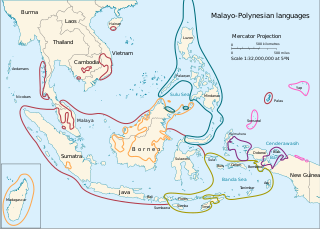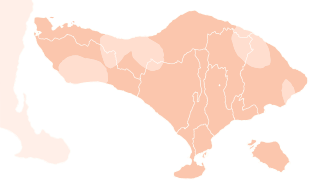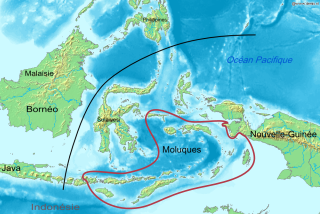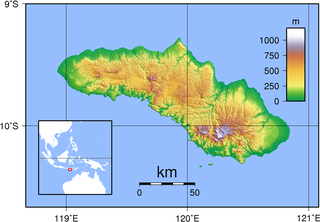Related Research Articles

The Malayo-Polynesian languages are a subgroup of the Austronesian languages, with approximately 385.5 million speakers. The Malayo-Polynesian languages are spoken by the Austronesian peoples outside of Taiwan, in the island nations of Southeast Asia and the Pacific Ocean, with a smaller number in continental Asia in the areas near the Malay Peninsula, with Cambodia, Vietnam and the Chinese island Hainan as the northwest geographic outlier. Malagasy, spoken in the island of Madagascar off the eastern coast of Africa in the Indian Ocean, is the furthest western outlier.

Balinese is a Malayo-Polynesian language spoken by 3.3 million people on the Indonesian island of Bali, as well as Northern Nusa Penida, Western Lombok, Eastern Java, Southern Sumatra, and Sulawesi. Most Balinese speakers also use Indonesian. The Bali Cultural Agency estimated in 2011 that the number of people still using the Balinese language in their daily lives on the Bali Island is under 1 million. The language has been classified as "not endangered" by Glottolog.
The Western Malayo-Polynesian (WMP) languages, also known as the Hesperonesian languages, are a paraphyletic grouping of Austronesian languages that includes those Malayo-Polynesian languages that do not belong to the Central–Eastern Malayo-Polynesian (CEMP) branch. This includes all Austronesian languages spoken in Madagascar, Mainland Southeast Asia, the Philippines, Indonesia, Palau and the Mariana Islands.
The Central–Eastern Malayo-Polynesian (CEMP) languages form a proposed branch of the Malayo-Polynesian languages consisting of over 700 languages.
The Sikka language or Sikkanese, also known as Sika, is spoken by around 180,000 people of the Sika ethnic group on Flores island in East Nusa Tenggara province, Indonesia. It is a member of the Central Malayo-Polynesian branch of the Austronesian language family.

The Sasak language is spoken by the Sasak ethnic group, which make up the majority of the population of Lombok, an island in the West Nusa Tenggara province of Indonesia. It is closely related to the Balinese and Sumbawa languages spoken on adjacent islands, and is part of the Austronesian language family. Sasak has no official status; the national language, Indonesian, is the official and literary language in areas where Sasak is spoken.

The Central Malayo-Polynesian languages (CMP) are a proposed branch in the Malayo-Polynesian subgroup of the Austronesian language family. The languages are spoken in the Lesser Sunda and Maluku Islands of the Banda Sea, in an area corresponding closely to the Indonesian provinces of East Nusa Tenggara and Maluku and the nation of East Timor, but with the Bima language extending to the eastern half of Sumbawa Island in the province of West Nusa Tenggara and the Sula languages of the Sula archipelago in the southwest corner of the province of North Maluku. The principal islands in this region are Sumbawa, Sumba, Flores, Timor, Buru, and Seram. The numerically most important languages are Bima, Manggarai of western Flores, Uab Meto of West Timor, and Tetum, the national language of East Timor.

The South Halmahera–West New Guinea (SHWNG) languages are a branch of the Malayo-Polynesian languages, found in the islands and along the shores of the Halmahera Sea in the Indonesian province of North Maluku and of Cenderawasih Bay in the provinces of Papua and West Papua. There are 38 languages.
The Sumba–Hawu languages are a group of closely related Austronesian languages, spoken in East Nusa Tenggara, Indonesia.
The Sumba–Flores languages, which correspond to the traditional "Bima–Sumba" subgroup minus Bima, are a proposed group of Austronesian languages spoken on and around the islands of Sumba and western–central Flores in the Lesser Sundas, Indonesia. The main languages are Manggarai, which has half a million speakers on the western third of Flores, and Kambera, with a quarter million speakers on the eastern half of Sumba Island.
Kei is an Austronesian language spoken in a small region of the Moluccas, a province of Indonesia.

The Hawu language is the language of the Savu people of Savu Island in Indonesia and of Raijua Island off the western tip of Savu. Hawu has been referred to by a variety of names such as Havu, Savu, Sabu, Sawu, and is known to outsiders as Savu or Sabu. Hawu belongs to the Malayo-Polynesian branch of the Austronesian language family, and is most closely related to Dhao and the languages of Sumba. Dhao was once considered a dialect of Hawu, but the two languages are not mutually intelligible.

The Savu languages, Hawu and Dhao, are spoken on Savu and Ndao Islands in East Nusa Tenggara, Indonesia.
The Bima language, or Bimanese, is an Austronesian language spoken on the eastern half of Sumbawa Island, Indonesia, which it shares with speakers of the Sumbawa language. Bima territory includes the Sanggar Peninsula, where the extinct Papuan language Tambora was once spoken. Bima is an exonym; the autochthonous name for the territory is Mbojo and the language is referred to as Nggahi Mbojo. There are over half a million Bima speakers. Neither the Bima nor the Sumbawa people have alphabets of their own for they use the alphabets of the Bugis and the Malay language indifferently.

The Lamahalot or Solorese people are an indigenous tribe located on Flores Island, Indonesia, and some smaller islands around it. Lamaholot people speak the Lamaholot language with different dialects, the number of speakers counts between 150,000 and 200,000.
Lamaholot, also known as Solor or Solorese, is a Central Malayo-Polynesian dialect cluster of Flores, Indonesia. The varieties may not be all mutually intelligible; Keraf (1978) reports that there are 18 languages under the name.

Lewotobi is either a separate Central Malayo-Polynesian language or dialect of Lamaholot of Flores island in Indonesia. It is presented as a separate language by Ethnologue and Grimes (1997). Nagaya (2011), in his description of Lewotobi, disputes this, classifying it instead as a dialect of Lamaholot.
Lamboya or Laboya is an Austronesian language spoken on Sumba, Indonesia. The population figure may include Gaura, which Ethnologue counts as a dialect of both Lamboya and Kodi.
The Flores–Lembata languages are a group of related Austronesian languages spoken in the Lesser Sundas, on eastern Flores and small islands immediately east of Flores, Indonesia. They are suspected of having a non-Austronesian substratum, with extreme morphological simplification in Sika and secondarily in Alorese, but not to a greater extent than the Central Malayo-Polynesian languages in general.

The Sumba languages are a subgroup of the Austronesian language family, spoken on Sumba, an island in eastern Indonesia. They are closely related to the Hawu–Dhao languages.
References
- ↑ Kodi at Ethnologue (17th ed., 2013)

- ↑ "Kodi". Ethnologue. Retrieved 2017-04-29.
- ↑ "Verbix Languages Languages/Kodi". wiki.verbix.com. Retrieved 2017-04-29.
- ↑ "Glottolog 3.0 – Kodi-Gaura". glottolog.org. Retrieved 2017-04-29.
- ↑ Hoskins, Janet (1993). The Play of Time: Kodi Perspectives on Calendars, History, and Exchange. Berkeley: University of California Press. ISBN 0-520-20892-7.
- ↑ "Kodi [kod]". Global Recordings Network. Archived from the original on 2016-03-12. Retrieved 2017-04-30.
- 1 2 Ekayani, Ni Putu; Mbete, Aron Meko; Putra, A.A. (2016). "Sistem fonologi bahasa Kodi di pulau Sumba". Linguistika: Buletin Ilmiah Program Magister Linguistik Universitas Udayana (in Indonesian). 21: 1–18.
- ↑ "Words of Life – Kodi". Global Recordings Network. Archived from the original on 2017-04-24. Retrieved 2017-04-29.
- ↑ Hoskins, Janet Alison (1986). "So My Name Shall Live: Stone-Dragging and Grave-Building in Kodi, West Sumba". Bijdragen tot de Taal-, Land- en Volkenkunde. 142 (1): 31–51. doi: 10.1163/22134379-90003367 . JSTOR 27863717.